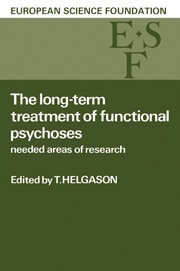Book contents
- Frontmatter
- Contents
- List of Participants
- Introduction
- I Organisational Aspects of Long-term Treatment
- II Patients Aspects of Long-term Treatment
- III Public Health Aspectsof Long-term Treatment
- Introduction to public health aspects of chronic illness and long-term treatment
- Evaluation of long-term community care for patients with schizophrenia
- Case registers for monitoring treatment outcome in chronic functional psychoses
- Socialdisabilityand chronicmentaldisorder
- The neglect of the patient with chronic functional psychosis: the need for further research
- Suicidesand functional psychoses
- Interaction with families
- Cost-effectiveness analysis
- Consumption of services-European aspects
- Index
Consumption of services-European aspects
from III - Public Health Aspectsof Long-term Treatment
- Frontmatter
- Contents
- List of Participants
- Introduction
- I Organisational Aspects of Long-term Treatment
- II Patients Aspects of Long-term Treatment
- III Public Health Aspectsof Long-term Treatment
- Introduction to public health aspects of chronic illness and long-term treatment
- Evaluation of long-term community care for patients with schizophrenia
- Case registers for monitoring treatment outcome in chronic functional psychoses
- Socialdisabilityand chronicmentaldisorder
- The neglect of the patient with chronic functional psychosis: the need for further research
- Suicidesand functional psychoses
- Interaction with families
- Cost-effectiveness analysis
- Consumption of services-European aspects
- Index
Summary
Introduction
The Mental Health Programme of the World Health Organization (WHO) has, for 10 years, been promoting a consistent policy for the development of mental health services. This policy is one based upon the provision of comprehensive community-based mental health care. In this, the principal features are unequivocal. The size of large mental hospitals should be reduced; alternative in-patient treatment facilities should be provided (preferably within general hospitals alongside other medical specialities); residential care should be as near to the population it serves as possible; out-patient and day care facilities should be available wherever patients needs can be met without admission to hospital; non-medical extramural care by nurses, social workers and the like should be developed; and mental health personnel should work as much as possible in multidisciplinary teams, serving defined populations.
Many of these essential policy elements are not measurable in strict statistical terms, but some can be translated into indicators or measures of identifiable trends. Some possible indicators are presented in this chapter; these are derived partly from data presently available at a macro-level, from a selection of countries in Europe. From data available at a micro-level, some detail of the use of services by long-term psychotic patients is shown.
Indicators of trends
A reduction in the number of mental hospitals with more than 1000 beds
Although in inter-country comparison, there is some difficulty in defining what a mental hospital is, there is no difficulty thereafter in identifying those institutions which contain more than 1000 beds. It is an assumption however that where the size of these hospitals has decreased, some alternative modes of care have been developed.
In the 19 countries for which we have comparable data on mental hospitals, there was a total of 232 mental hospitals of over 1000 beds in 1972 which had diminished to only 97 hospitals by 1982. Five hospitals with over 2000 beds were reported in 1972, but none existed 10 years later. Italy (with a reduction from 55 to 20 large hospitals) and the United Kingdom (with a reduction from 65 to 31) provide striking examples. In the other 17 countries there was a total of 112 large mental hospitals in 1972 and only 46 in 1982.
- Type
- Chapter
- Information
- The Long-Term Treatment of Functional PsychosesNeeded Areas of Research, pp. 255 - 260Publisher: Cambridge University PressPrint publication year: 1985

